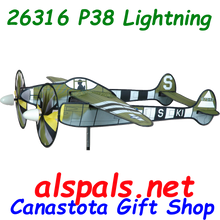 Loading... Please wait...
Loading... Please wait...Categories
New Products
-
$69.95$53.95
-
$33.95$23.95
-
$33.95$23.95
-
$69.95$53.95
-
$78.95$69.95
Our Newsletter
- Home
- Wind Spinner Store by WindGarden
- Airplane Wind Spinners
- P-38 Lightning 27" : Airplane Spinners
P-38 Lightning 27" : Airplane Spinners
Sorry but this item is currently unavailable.
Please check back at a later stage.
Product Description
P-38 Lightning 27": Airplane Wind Spinners
Size: 27.5 in. X 38 in.
Windgarden by Premier design featured by Canastota Gift Shop
Celebrate early flight with our most engaging lawn ornaments, the P-38 Lightning 27": Airplane Wind Spinners. The P-38 Lightning 27": Airplane Wind Spinners bring an air of nostalgia to whatever yard they land upon. With a striking attention to detail, our P-38 Lightning 27": Airplane Wind Spinners are a timeless way to bring the golden age of aviation right to your yard. The neighborhood boys (Young & Old) will be planning their strategies, as these propellers spin in the slightest of breeze on these P-38 Lightning 27": Airplane Wind Spinners. Order several P-38 Lightning 27": Airplane Wind Spinners now to get your air force in shape and the pilots can get their training in with these P-38 Lightning 27": Airplane Wind Spinners from Windgarden by Premier designs. If this isn't an air of nostalgia what is? Yes Canastota Gift Shop can fly your P-38 Lightning 27": Airplane Wind Spinners to you. !! Order NOW !! !! Everybody will be glad you did !!
http://instructions.premierkites.com/25316_P38Lightning.pdf
The Lockheed P-38 Lightning is a World War II-era American piston-engined fighter aircraft. Developed to a United States Army Air Corps requirement, the P-38 had distinctive twin booms and a central nacelle containing the cockpit and armament. Allied propaganda claimed it had been nicknamed the fork-tailed devil (German: der Gabelschwanz-Teufel) by the Luftwaffe and "two planes, one pilot" (2飛行機、1パイロット Ni hikōki, ippairotto) by the Japanese.[7] The P-38 was used for interception, dive bombing, level bombing, ground attack, night fighting, photo reconnaissance, radar and visual pathfinding for bombers and evacuation missions,[8] and extensively as a long-range escort fighter when equipped with drop tanks under its wings.
The P-38 was used most successfully in the Pacific Theater of Operations and the China-Burma-India Theater of Operations as the aircraft of America's top aces, Richard Bong (40 victories), Thomas McGuire (38 victories) and Charles H. MacDonald (27 victories). In the South West Pacific theater, the P-38 was the primary long-range fighter of United States Army Air Forces until the appearance of large numbers of P-51D Mustangs toward the end of the war.[9][10]
The P-38 was unusually quiet for a fighter, the exhaust muffled by the turbo-superchargers. It was extremely forgiving and could be mishandled in many ways but the rate of roll in the early versions was too slow for it to excel as a dogfighter.[11] The P-38 was the only American fighter aircraft in high-volume production throughout American involvement in the war, from Pearl Harbor to Victory over Japan Day.[12] At the end of the war, orders for 1,887 more were cancelled.[13]








